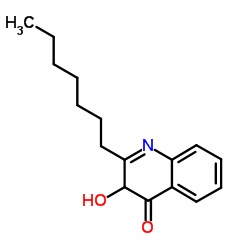Quinolone signaling in the cell-to-cell communication system of Pseudomonas aeruginosa.
E C Pesci, J B Milbank, J P Pearson, S McKnight, A S Kende, E P Greenberg, B H Iglewski
Index: Proc. Natl. Acad. Sci. U. S. A. 20th ed., 96 , 11229-11234, (1999)
Full Text: HTML
Abstract
Numerous species of bacteria use an elegant regulatory mechanism known as quorum sensing to control the expression of specific genes in a cell-density dependent manner. In Gram-negative bacteria, quorum sensing systems function through a cell-to-cell signal molecule (autoinducer) that consists of a homoserine lactone with a fatty acid side chain. Such is the case in the opportunistic human pathogen Pseudomonas aeruginosa, which contains two quorum sensing systems (las and rhl) that operate via the autoinducers, N-(3-oxododecanoyl)-L-homoserine lactone and N-butyryl-L-homoserine lactone. The study of these signal molecules has shown that they bind to and activate transcriptional activator proteins that specifically induce numerous P. aeruginosa virulence genes. We report here that P. aeruginosa produces another signal molecule, 2-heptyl-3-hydroxy-4-quinolone, which has been designated as the Pseudomonas quinolone signal. It was found that this unique cell-to-cell signal controlled the expression of lasB, which encodes for the major virulence factor, LasB elastase. We also show that the synthesis and bioactivity of Pseudomonas quinolone signal were mediated by the P. aeruginosa las and rhl quorum sensing systems, respectively. The demonstration that 2-heptyl-3-hydroxy-4-quinolone can function as an intercellular signal sheds light on the role of secondary metabolites and shows that P. aeruginosa cell-to-cell signaling is not restricted to acyl-homoserine lactones.
Related Compounds
| Structure | Name/CAS No. | Molecular Formula | Articles |
|---|---|---|---|
 |
2-Heptyl-3-hydroxy-4(1H)-quinolinone
CAS:108985-27-9 |
C16H21NO2 |
|
3-indolylacetonitrile decreases Escherichia coli O157:H7 bio...
2011-01-01 [Environ. Microbiol. 13 , 62-73, (2011)] |
|
The Pseudomonas aeruginosa 4-quinolone signal molecules HHQ ...
2007-01-01 [Chem. Biol. 14 , 87-96, (2007)] |
|
Differential immune modulatory activity of Pseudomonas aerug...
2004-11-01 [Infect. Immun. 72(11) , 6463-6470, (2004)] |
|
Indole and 7-hydroxyindole diminish Pseudomonas aeruginosa v...
2009-01-01 [Microb. Biotechnol. 2 , 75-90, (2009)] |
|
7-fluoroindole as an antivirulence compound against Pseudomo...
2012-04-01 [FEMS Microbiol. Lett. 329 , 36-44, (2012)] |